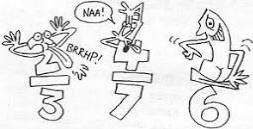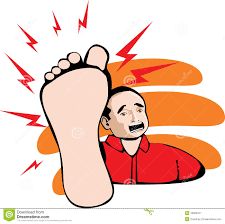
| “That’s two-thirds of a husband to each wife,” Giuseppe calculates. Told by
Tessa that “one can’t marry a vulgar fraction,” he takes umbrage: “You’ve no
right to call me a vulgar fraction.” The Gondoliers |

D Vautier
4/2023
 5000 years ago Egyptian astronomers first started to use
fractions by determining that the year was 365 ¼ days long. They observed that
the simultaneous rising of Sirius and the sun happened regularly every 365 days
but noticed that every 4 years the sun was a day late. The Pharaohs didn’t like
the idea of vulgar fractions and so adopted a more proper political calendar consisting of
just 365 days, and so the political calendar was right every 1460 years.
5000 years ago Egyptian astronomers first started to use
fractions by determining that the year was 365 ¼ days long. They observed that
the simultaneous rising of Sirius and the sun happened regularly every 365 days
but noticed that every 4 years the sun was a day late. The Pharaohs didn’t like
the idea of vulgar fractions and so adopted a more proper political calendar consisting of
just 365 days, and so the political calendar was right every 1460 years.
 So for at least 5000 years civilization had no concept or
interest in fractions, and any use of coinage avoided fractions by simply using
multiple coins of different value, like pounds, shillings, pence, quarters,
franks, centimes, drachmas, and before then values were in sheep, goats,
chickens, cows,
wolf skins, beaver skins, etc., each having relative or fractional value to the
other,
So for at least 5000 years civilization had no concept or
interest in fractions, and any use of coinage avoided fractions by simply using
multiple coins of different value, like pounds, shillings, pence, quarters,
franks, centimes, drachmas, and before then values were in sheep, goats,
chickens, cows,
wolf skins, beaver skins, etc., each having relative or fractional value to the
other,
 Even distances were measured avoiding fractions. People
just invented smaller units of measure; miles, cubits, yards, feet, inches –
anything to avoid those vulgar fractions. When the new
Hindu-Arabic numbering
system came into moderate use around 1500, the idea of fractions was
still unknown and quite unwelcome for that matter. It would be another century
before it started to occur to people that numerical fractions were absolutely
vital for any kind of higher scientific activity. Much better than using goat skins.
Even distances were measured avoiding fractions. People
just invented smaller units of measure; miles, cubits, yards, feet, inches –
anything to avoid those vulgar fractions. When the new
Hindu-Arabic numbering
system came into moderate use around 1500, the idea of fractions was
still unknown and quite unwelcome for that matter. It would be another century
before it started to occur to people that numerical fractions were absolutely
vital for any kind of higher scientific activity. Much better than using goat skins.
 So along came the
great John Napier (1550-1617), an absolute genius from Scotland. Not only did he discover
logarithms but he invented the decimal point by the way. That single invention freed
mathematics from the sheer tyranny of whole numbers. It revolutionized the entire
world of mathematics. It allowed ways to express real big and real small
numbers. It was able to show exact relationships and ratios and became the
untold grief of every 4th grader. It made our
modern system of science and industry. It converted latitude and longitude
into straight usable numbers. We became a world of vulgar fractions.
So along came the
great John Napier (1550-1617), an absolute genius from Scotland. Not only did he discover
logarithms but he invented the decimal point by the way. That single invention freed
mathematics from the sheer tyranny of whole numbers. It revolutionized the entire
world of mathematics. It allowed ways to express real big and real small
numbers. It was able to show exact relationships and ratios and became the
untold grief of every 4th grader. It made our
modern system of science and industry. It converted latitude and longitude
into straight usable numbers. We became a world of vulgar fractions.